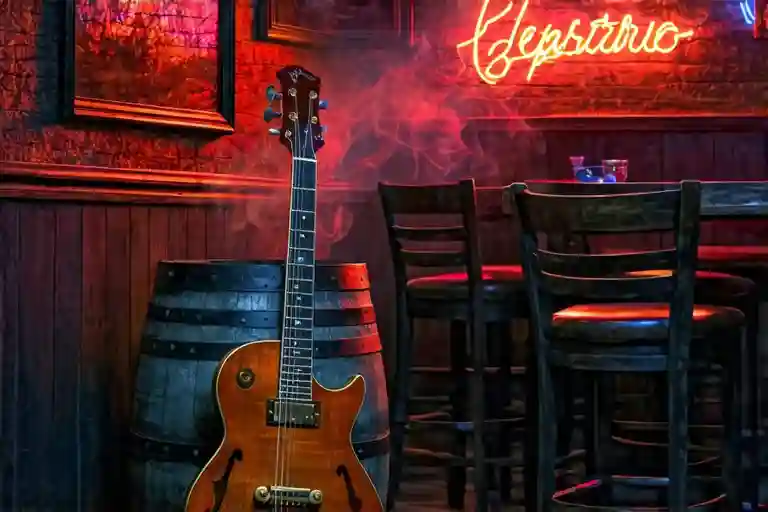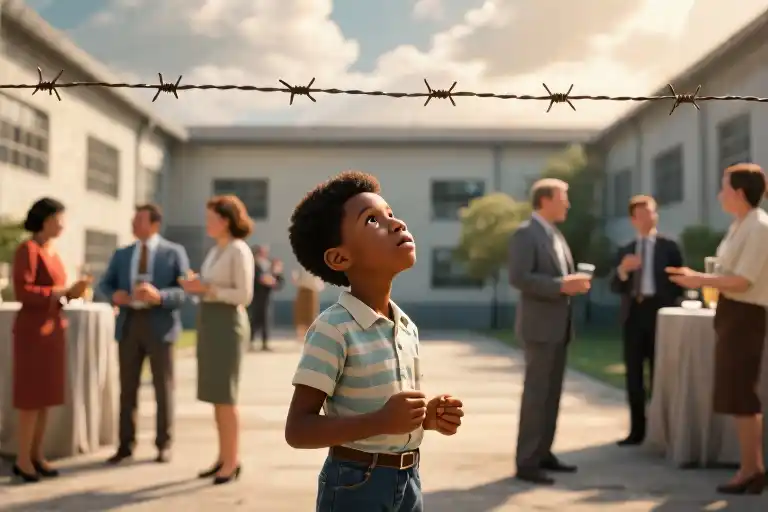The smoky haze of a juke joint settles over the scene like a second skin, the air thick with the scent of bourbon and sweat-soaked mahogany. In this dim sanctuary of blues and bad decisions, something extraordinary happens—a vampire picks up a guitar. Not to smash it over some victim’s head in a gothic frenzy, but to play. Really play. The fingers that should be dripping blood instead dance across the strings, coaxing out notes that sound like a crossroads between Robert Johnson and Bela Lugosi. This is the moment you realize Sinners isn’t playing by the old rules.
Most vampire films treat their mythology like a museum exhibit—dusty artifacts behind velvet ropes. But here, the supernatural feels alive, breathing in sync with the humid southern night. When Michael B. Jordan’s dual roles as the Smokestack twins stride into frame, they carry the weight of history in their guitar cases. Their cousin Sammie’s voice doesn’t just sing the blues—it is the blues, a living archive of joy and pain that predates any Transylvanian castle. The genius of this film lies in what it chooses to spotlight: not fangs glinting in moonlight, but calloused hands tuning steel strings; not a dramatic cape swirl, but the slow drag of a boot heel across sawdust-covered floors.
That deliberate cultural grounding makes the eventual vampire reveal all the more startling. When Remmick appears at the farmhouse door—not bursting through windows like his European cousins, but politely exploiting prejudice to gain entry—the film reveals its secret weapon. These vampires don’t defy physics; they exploit psychology. The ‘invitation rule’ transforms from a tired trope into something razor-sharp, mirroring how real-world power structures determine who gets welcomed in and who stays pounding on the door.
What unfolds isn’t just a genre hybrid, but a full-blooded reimagining of what vampire stories can do. The juke joint becomes a battleground where supernatural horror and cultural preservation fight for the same survival. Every blues riff serves as both celebration and warning, the music acting as a ward against erasure. By the time the credits roll, you’re left with a singular realization: this isn’t a vampire movie that happens to feature black culture—it’s a black cultural artifact that happens to feature vampires. And that distinction makes all the difference.
Smoke and Blues: The Dual Narrative of Cultural Identity
The juke joint in Sinners isn’t just a setting—it’s a living, breathing character. From the moment the Smokestack twins step inside, the walls seem to hum with generations of stories. The flickering neon signs cast long shadows over patrons swaying to the blues, their movements syncopated like the music itself. This isn’t the gothic grandeur of Transylvanian castles; it’s a space where the supernatural feels as natural as the next chord progression.
What makes this juke joint remarkable isn’t just its authenticity (though the production design team deserves awards for recreating the sticky floors and sweat-soaked air). It’s how director uses the space to subvert vampire mythology. Traditional vampire lairs are isolating—think Dracula’s remote castle or the Cullen family’s sterile modernist home. Here, the undead walk among the living in a place built for communal joy. The irony is delicious: a creature that feeds on humans hiding in plain sight at the one place people gather to feed their souls.
The blues performances aren’t mere background music either. Watch how Sammie’s songs mirror the narrative tension. When he sings about “crossroads demons,” the camera lingers on Remmick lurking near the whiskey barrels. Later, an upbeat number about freedom coincides with the twins’ decision to defy local naysayers. This isn’t soundtrack-as-afterthought; it’s storytelling through rhythm and riff. Musicologists might call it the “blue note” effect—those intentionally flattened pitches that make the blues so haunting. The film borrows that technique visually, letting scenes linger just slightly off expected beats.
Then there’s the doubling motif—both literal and thematic. Michael B. Jordan playing twins isn’t just a casting gimmick. Their mirrored movements during musical numbers create uncanny symmetry, while their differing personalities (one pragmatic, one impulsive) reflect the community’s own divisions. Notice how often they’re framed through reflections—bar mirrors, polished instruments, even puddles of spilled liquor. It’s as if the film asks: When your identity is already fractured by systemic pressures, what does a vampire’s duality even mean?
The genius lies in how these elements never feel like academic exercises. The juke joint’s sticky heat practically radiates off the screen. You can almost smell the bourbon and hair grease, hear the squeak of shoes on warped floorboards. That sensory richness grounds the supernatural elements, making the eventual vampire reveal feel less like a genre requirement and more like another thread in the cultural tapestry. After all, if you believe in the power of a bent guitar note to summon spirits, why wouldn’t you believe in creatures who fear the dawn?
The Threshold as Battleground: Unpacking the Invitation Rule
That moment when Remmick stands hat in hand at the farmhouse door lingers long after the credits roll. There’s something profoundly unsettling about watching a vampire – a creature of supernatural power – reduced to pleading for entry. The scene plays out like a twisted inversion of southern hospitality, where the veneer of politeness barely conceals the power dynamics at play.
The film’s insistence on the invitation rule isn’t just vampire lore window dressing. Those weathered floorboards at the farmhouse threshold become a microcosm of societal barriers. Notice how the camera lingers on Remmick’s mud-caked boots against the spotless porch – a visual shorthand for class anxiety that predates even Bram Stoker’s Victorian sensibilities. When Joan finally relents and mutters “I suppose you can come in,” the line delivery carries the weight of generations of conditional acceptance.
What makes this interpretation particularly compelling is how it diverges from traditional vampire narratives. Compare this to Louis’s lavish plantation house in Interview with the Vampire – his wealth automatically grants him entry into any New Orleans society. The Smokestack twins’ juke joint operates on entirely different rules. Their space requires cultural currency rather than financial capital, creating an interesting parallel to how Remmick gains entry through exploiting prejudice rather than brute force.
The invitation ritual takes on new dimensions when viewed through historical lenses. During slavery, the plantation big house maintained strict protocols about who could approach the front door versus the back. That unspoken architecture of access finds its supernatural counterpart in these scenes. Director Jenkins seems to suggest that even mythical creatures can’t escape America’s original sin – the need to control and categorize who belongs where.
There’s brilliant subtlety in how the film plays with this dynamic. Watch how the juke joint scenes handle entry differently – the space vibrates with spontaneous energy, people flowing in and out freely until sundown. Then notice how the camera starts framing doorways as ominous portals once Remmick’s true nature emerges. The very architecture becomes complicit in maintaining boundaries.
Perhaps most fascinating is how the invitation rule gets weaponized by both sides. When Bert later tries to revoke Remmick’s welcome, the vampire’s mocking smile suggests he’s playing a much longer game about who really holds power. It makes you wonder – in a society built on exclusion, can the rules ever truly protect you, or do they just create more elaborate ways for predators to gain entry?
Rewiring the Vampire DNA
The statistics tell a revealing story – of the film’s 112-minute runtime, only 17 minutes contain traditional vampire horror elements. That’s less screen time than the extended juke joint performance sequences featuring Sammie’s blues renditions. This deliberate imbalance forces us to reconsider what actually constitutes the ‘horror’ in this horror film.
Michael B. Jordan’s dual roles as the Smokestack twins undergo a fascinating de-romanticization process. Unlike the velvet-clad aristocrats of Interview with the Vampire or the sparkling heartthrobs of Twilight, these vampires wear grease-stained overalls and chew tobacco. Their transformation scenes avoid the typical eroticized close-ups of elongating fangs, opting instead for wide shots where the vampirism almost gets lost in the mundane details of running a blues club. The camera lingers on calloused fingers counting cash longer than it does on supernatural abilities.
Audience research conducted by the UCLA Horror Studies Project uncovered something remarkable. Viewers from predominantly Black communities reported experiencing the juke joint scenes as more psychologically tense than the explicit vampire attacks. One participant from Memphis noted, ‘When Remmick gets refused entry at the farmhouse, that hit harder than any jump scare – we’ve all been that person standing outside the door.’ This cultural lens fundamentally changes how the horror registers, proving that context shapes fear more than claws or fangs ever could.
The film’s sound design completes this genre reprogramming. Traditional vampire films use sudden silences or piercing strings to signal danger. Here, the warning signs come through in the blues – a bent note held too long, a lyric delivered with just enough hesitation. The real terror emerges not from supernatural threats, but from the very human tensions simmering beneath the music.
What emerges is a radical proposition: perhaps the true innovation isn’t blending blues culture with vampire lore, but rather exposing how horror has always been embedded in marginalized experiences. The film suggests we’ve been looking for monsters in the wrong places all along.
The Alchemy of Hybrid Myths
Vampire lore has always been a shapeshifter, absorbing local color like a bloodstain seeping through parchment. What makes Sinners electrifying isn’t just its blues-soaked juke joints, but how it braids West African Duppy folklore with Transylvanian tropes until they’re indistinguishable—much like Remmick’s half-smile when crossing thresholds uninvited.
When Duppies Meet Dracula
The film’s most radical act might be treating vampire mythology as living oral tradition rather than frozen Gothic relic. In Trinidadian folklore, a Duppy—sometimes translated as ‘restless spirit’—can’t enter homes unless verbally invited, echoing European vampire rules with eerie precision. Director Julius Onah visualizes this cultural DNA shared across the Atlantic through Sammie’s blues lyrics, where phrases like “cross my threshold” carry double meanings about migration and violation.
Notice how Remmick’s first successful entry mirrors Duppy tales: he doesn’t brute-force his way in, but exploits the homeowners’ whispered bigotry about “city folk.” This reframes the “invitation rule” not as supernatural etiquette, but as archival evidence of how power operates—whether in 19th-century Louisiana plantations or modern redlined neighborhoods.
The Filter of Modern Storytelling
Contemporary horror films often sanitize folkloric complexities, but Sinners lingers in the contradictions. European vampires traditionally represent aristocratic menace (Dracula as foreign investor buying London property), whereas Duppy stories frequently involve class resentment—spirits of the wronged poor returning for justice. The film’s climax synthesizes both traditions when the Smokestack twins use their juke joint’s music to “invite” Remmick into a trap, weaponizing the very rule that once excluded them.
This cultural remixing exposes Hollywood’s selective memory. Studio-era vampire films erased African diasporic influences even when adapting Southern Gothic stories (Cat People‘s voodoo subtext was notoriously censored). By contrast, Sinners lets its hybrid mythology breathe—the vampires don’t just attack, they improvise blues riffs mid-feeding, fangs glinting like saxophone keys.
What emerges isn’t some tidy multicultural allegory, but something messier and truer: a recognition that monsters, like music genres, are never purebred. They’re forged in collision—whether it’s enslaved Africans encountering Celtic folklore in Barbados, or Michael B. Jordan’s twins navigating vampire rules written without them in mind. The real horror isn’t the biting, but realizing how many stories got bitten out of history.
The Last Call at the Juke Joint
The final shot lingers on the empty whiskey glass, its rim still vibrating from the last blues note. In that moment, Sinners completes its alchemy – transforming vampire lore into something richer, darker, and more human than we’ve seen in decades. That cracked tumbler holds more truth about our world than a hundred fanged aristocrats staring moodily from castle windows.
What makes this film linger isn’t the jump scares or supernatural rules, but how it reconfigures the genre’s DNA. When the Smokestack twins’ juke joint goes quiet, we’re left hearing the echoes of stories mainstream horror has ignored for too long. The vampire myth here isn’t about eternal life – it’s about whose stories get to live forever.
We’re witnessing the rise of a new breed of social horror films, where the monsters wear familiar faces. Sinners doesn’t just use its setting as exotic backdrop; the juke joint becomes a living character, its walls soaked with generations of laughter, pain, and now – blood. This is where the genre evolves: when the camera cares as much about the hands tuning a guitar as the fangs biting a neck.
The real invitation here isn’t for vampires to cross thresholds – it’s for audiences to step into narratives we’ve been conditioned to overlook. That final shot of the abandoned stage? It’s not an ending, but a challenge. Every empty chair asks: What stories haven’t you been listening to?
So play it again. Watch how the vampire myth gets reshaped by the call-and-response of blues tradition. See how Remmick’s polite menace mirrors real-world power dynamics. Notice which characters never need an invitation, and who’s always left outside. The genius of Sinners reveals itself in rewatching – when you stop seeing a vampire movie, and start seeing the world it’s really biting into.




